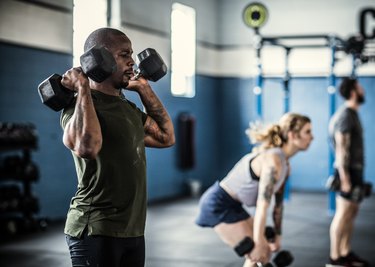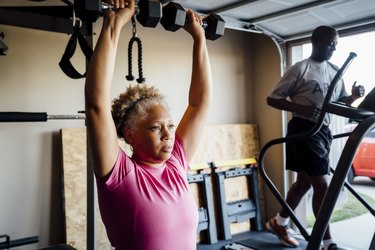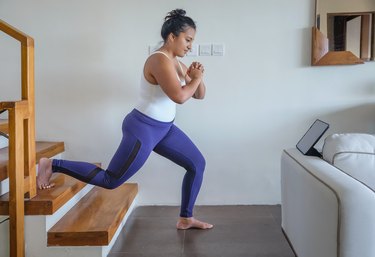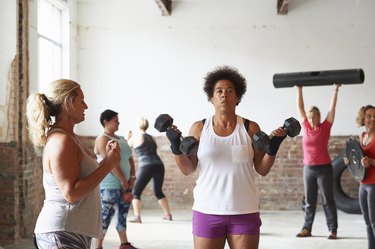
Strength training for beginners can feel a little intimidating. But you don't need to spend hours in the gym or lift super-heavy weights to get a good muscle-building workout.
Strength training is actually a very accessible — and safe — activity for people of all levels. Even the U.S. government recommends at least two full-body, strength-training workouts a week in its Physical Activity Guidelines for Americans.
Video of the Day
Here's everything you need to know about weight training for beginners, including which strength exercises you should use to get started.
7 Common Types of Strength Training
Whether you're working out at the gym or at home, there are several different types of strength training you might want to pursue. Most commonly, you'll hear about:
1. Body-Weight
Body-weight exercises are no-equipment-needed moves that use only the resistance created by your body weight (hence the name) to build muscle. These are a big part of strength training for beginners. It's always wise to master exercise form without any gear before adding bands, weights, or other exercise equipment.
2. Resistance-Band
Resistance-bands include mini bands, tubes with handles, long looped bands and latex elastic bands. These come in different levels of resistance to help build muscle without adding pressure on the joints
3. Suspension
The most common suspension training system is the TRX. It a a series of straps anchored to the ceiling or wall (you might've seen the signature black-and-yellow straps at your gym) and allows you to perform moves that again rely on your body weight for resistance.
4. Dumbbell
Dumbbell workouts are a great place for many strength-training beginners to start because dumbbells are really common to already have around the house.
5. Kettlebell
Kettlebell workouts are a fun way to mix things up. Kettlebells are metal balls with U-shaped handles on top. You might think about them as being for complicated moves like kettlebell swings, but they're also great for beginner exercises like goblet squats.
6. Barbell
Barbell workouts are best once you've mastered basic strength training skills with dumbbells. Barbells are long metal bars that you can make heavier by adding weighted (and secured) plates to the ends.
7. Machine
Strength machines are designed to work specific parts of the body using weights and moving parts, such as cables and pulley systems.
Weightlifting Types
Within weightlifting, specifically, you may also hear about these types:
- General weightlifting: using free weights or weight machines to build strength
- Olympic weightlifting: involving two standard lifts — snatch and clean and jerk
- Powerlifting: only involves three exercises — squat, bench press and deadlift
- Bodybuilding: focusing on building a muscular appearance
- Strongman: focusing on building strength to display power, such as flipping cars
What You Need to Start Strength Training
The best place for strength-training beginners to start is a combination of body-weight exercises and weightlifting with dumbbells. You don't need a lot of equipment to strength train, and you don't need a laundry list of exercises. In fact, most trainers will make sure you don't overcomplicate your training, especially in your first few sessions.
"Routines involving body-weight exercises are a perfectly fine place to start, and these can be done in your home or at a park; many public parks have exercise stations with basic equipment such as parallel bars for dips, bars for chin-ups and more," says Jeremy Tully, a strength coach at Bay Strength.
If you're looking to invest in some equipment for your at-home workouts, start with two sets of dumbbells and resistance bands, says Mary Johnson, owner and performance coach at Lift | Run | Perform. However, both trainers note that as you progress from body weight to free weights and kettlebells, eventually you'll need access to more equipment or a gym to see proper gains.
The Basics of a Beginner Strength-Training Workout
How Long Should a Strength-Training Workout Be?
You don't need to put in hour-long sessions at first. In fact, since your body has yet to adapt, you may only need to spend 20 to 30 minutes per session. Or instead of paying attention to total time, focus on reps (the number of times to do an exercise) and sets (the number of times to repeat your reps).
If you focus on these numbers, you can make sure to practice proper form and complete each move correctly rather than racing to hit a certain marker on the clock (and increase your chance of injury).
Related Reading
How Many Days a Week Should You Strength Train?
For a beginner, two to three strength-training sessions a week is sufficient to stay healthy and meet your goals. As mentioned above, the physical guidelines for Americans recommend at least two full-body, strength-training workouts a week, though you may want to increase that number as you progress, depending on what your goals are.
Make sure you round out your routine with some sort of cardio, Tully says. "Optimal fitness and health will always be achieved via a combination of strength and cardio work," he says. "The precise balance depends on the individual, their goals and what activities they find most enjoyable and want to spend their limited free time pursuing."
The Best Strength-Training Exercises for Beginners
"Repetition and progressive overload [continually challenging your muscles by adding weight, reps or sets or changing exercises] of the five major movement patterns — squat, hinge, push, pull and carry — will yield incredible results," Johnson says.
Focusing on these movement patterns (which are the foundation for common strength-training exercises) can make you more efficient in your daily life, reduce the stress placed on your body doing physical tasks on the job and lower your risk of injury, according to the American Council on Exercise.
It's also a good idea to start with compound moves versus isolated, meaning choosing exercises that work multiple muscle groups instead of only focusing on one at a time. That's because compound moves will give you the greatest return on both time and energy, Tully says.
The American College of Sports Medicine recommends doing 8 to 10 compound exercises per workout for 2 to 3 sets of 8 to 12 reps. Ideally, you'll do compound exercises 2 to 3 times a week.
Here are six of the the best basic strength-training exercises to lay the foundation.
Move 1: Goblet Squat
- Begin with your feet planted shoulder-width apart, standing up straight with your head facing forward and shoulders relaxed. Hold one end of a dumbbell in front of your chest.
- Bend at the knees and as if sitting in a chair, bring your hips back and down. Your upper body may lean forward slightly with your back flat.
- Either bend your arms at the elbows with your hands clasped at your chest or extend your arms straight out in front of you.
- Keep your feet planted with weight in the heels. Your knees should remain over your ankles and behind your toes and shouldn’t fall inward.
- To finish the move, keep the weight in your heels and drive your body up to standing.
Move 2: Dumbbell Bench Press
- Lie on your back on a weight bench (or the floor) with a dumbbell in each hand. Hold the weights with straight arms above your chest. Plant your feet firmly on the floor and tighten your abs.
- Bend your elbows and lower the weights until they are in line with your chest.
- Press the weights back up over your chest.
Move 3: Dumbbell Shoulder Press
- Begin standing or seated with a flat back, feet rooted in the ground, holding a dumbbell in each hand.
- Lift the weights above your shoulders with your elbows bent at 90 degrees.
- On an exhale, brace your core and press both dumbbells overhead.
- Lower the weights back to the starting position with control.
Move 4: Dumbbell Lunge
- Grab two dumbbells and hold one in each hand. Stand tall with your feet together.
- Take a step forward with your right leg and plant your foot. Slowly lower your leg down so your knee is bent and stays over your ankle.
- At the same time, lower your back leg down to the floor (as low as you can go in order to keep your stance solid with your right leg).
- Stand back up and bring your right leg back together with your left.
- Repeat on the other side, stepping left leg forward.
Move 5: Dumbbell Row
- Stand with your feet hip-width apart and hold a dumbbell in each hand in front of your thighs. Shoot your hips back and hinge forward at least 45 degrees (as much as 90 degrees), keeping your back flat. Start with your arms extended toward the ground, palms facing each other.
- Draw your elbows up toward your ribs and pull the weights up alongside your lower abdomen.
- As you lift the weights, focus on squeezing the shoulder blades together.
- Lower back down to the start with control.
Move 6: Dumbbell Lateral Raise
- Start standing with a dumbbell in each hand, arms at your sides. Keep your back flat and knees slightly bent.
- Keeping your core braced, raise the weights out to your sides until they reach shoulder height.
- Lower the weights slowly to the starting position.
3 Beginner Strength-Training Workouts
Now it's time to put all these move together! Tully created three strength-training workouts for beginners with three moves each and recommends doing only one per strength-training day. While you feel you may be able to do more, starting with three moves per session as a beginner will help you develop work capacity.
Tip
Reps is the number of times you do an exercise (ex. 4 squats). Sets is the number of times you repeat that number of reps (ex. 4 squats, rest, repeat twice more).
Workout A: Repeat for 2 rounds
Reps | Sets | |
|---|---|---|
Goblet Squat | 4 | 3 |
Bench Press | 7 | 3 |
Bent-Over Row | 10 | 3 |
Workout B: Repeat for 2 rounds
Reps | Sets | |
|---|---|---|
Goblet Squat | 4 | 3 |
Shoulder Press | 7 | 3 |
Lateral Raise | 15 | 3 |
Workout C: Repeat for 2 rounds
Reps | Sets | |
|---|---|---|
Dumbbell Lunge | 14 | 3 |
Bench Press | 10 | 3 |
Bent-Over Row | 15 | 3 |
Even More Beginner Strength Exercises and Workouts
How to Stay Safe While Strength Training
Whether you're new to working out altogether or you already have an established cardio routine and are looking to add weight training, you may be worried about some of the potential side effects (the most-talked about being injury).
"[People believe] that strength training is risky, or that if it is performed without perfect technique, will lead to injury," Tully says. "In reality, proper load management — pushing hard and progressing over time but staying within your limits and keeping your lifts free of any major technical breakdown — provides a recipe for successful long-term training while minimizing the risk of injury."
Of course, technique is important and will get you the best results, but as a beginner, Tully reassures that if it isn't impeccable every time, this doesn't automatically mean you will get injured. That's all a part of learning.
If you still have doubts, approach strength training conservatively and start with body-weight exercises; you can always increase if needed. With strength training — especially as a beginner — taking your time to master the fundamentals will set you up for future success.
"Strength training is a long-term process, and we care less about how much someone adds to their squat in the first month of training than we do about laying a good foundation of positive training habits and good lifting technique early on," Tully says. "The weight on the bar will go up over time."
Once you start lifting weights, you may want to have a personal trainer or spotter coach you through your lifts, according to the American Academy of Family Physicians. And if anything hurts at any time — stop. It's better to rest for a few days to let your body recover. You won't lose your progress in those few days, but you may risk serious injury if you don't take time off.
Want to get started with a guided strength workout for beginners? This one requires just 10 minutes and a single set of weights.



